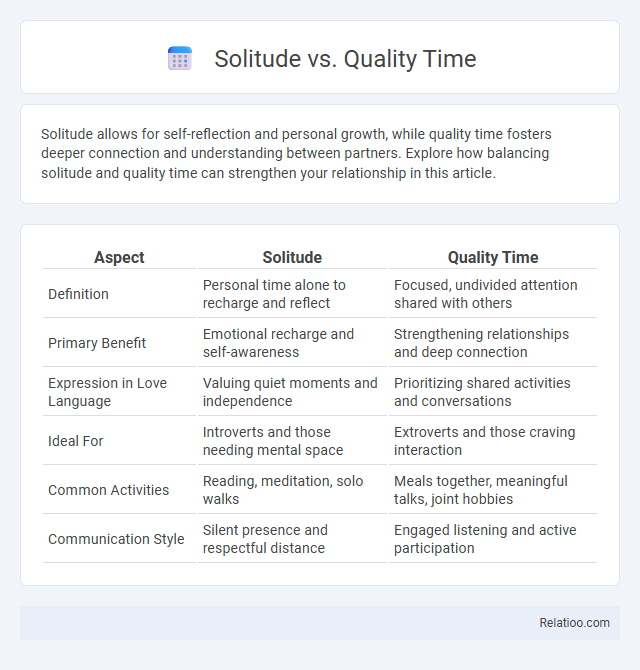Solitude allows for self-reflection and personal growth, while quality time fosters deeper connection and understanding between partners. Explore how balancing solitude and quality time can strengthen your relationship in this article.
Table of Comparison
| Aspect | Solitude | Quality Time |
|---|---|---|
| Definition | Personal time alone to recharge and reflect | Focused, undivided attention shared with others |
| Primary Benefit | Emotional recharge and self-awareness | Strengthening relationships and deep connection |
| Expression in Love Language | Valuing quiet moments and independence | Prioritizing shared activities and conversations |
| Ideal For | Introverts and those needing mental space | Extroverts and those craving interaction |
| Common Activities | Reading, meditation, solo walks | Meals together, meaningful talks, joint hobbies |
| Communication Style | Silent presence and respectful distance | Engaged listening and active participation |
Understanding Solitude: Definition and Benefits
Solitude is defined as the state of being alone without feeling lonely, offering significant mental clarity and emotional rejuvenation. Engaging in solitude enhances self-awareness, reduces stress, and fosters creativity by allowing uninterrupted reflection. Unlike quality time spent with others, solitude provides a unique opportunity for personal growth and introspection essential for cognitive and emotional balance.
What is Quality Time? Key Elements Explored
Quality Time involves focused, meaningful interaction that strengthens relationships by prioritizing presence, attention, and emotional connection. Key elements include active listening, uninterrupted engagement, and shared activities that foster trust and understanding. Unlike solitude, which centers on individual reflection, quality time emphasizes mutual participation and deepening bonds.
Psychological Impact: Solitude vs Quality Time
Quality time fosters emotional connection and strengthens relationships by promoting shared experiences and mutual understanding, which enhances your psychological well-being. Solitude offers crucial opportunities for self-reflection, mental restoration, and stress reduction by allowing your mind to recharge without external distractions. Balancing solitude with quality time ensures optimal mental health by combining social bonding and personal introspection.
Solitude and Self-Discovery: Embracing Alone Time
Solitude offers a powerful opportunity for self-discovery by allowing you to connect deeply with your thoughts and emotions without external distractions. Embracing alone time fosters introspection, enhances creativity, and promotes personal growth, making it essential for mental clarity and emotional balance. Prioritizing solitude in your routine helps you recharge and gain valuable insights into your true desires and goals.
Building Relationships Through Quality Time
Quality time is essential for building strong relationships as it fosters meaningful connections and deepens understanding between individuals. Unlike solitude, which offers personal reflection and peace, spending quality time together encourages communication and shared experiences that create lasting bonds. Your intentional focus on quality time strengthens trust and emotional intimacy, essential components for healthy and supportive relationships.
Productivity: When Solitude Helps You Thrive
Solitude enhances productivity by providing uninterrupted focus, allowing the mind to recharge and engage deeply with complex tasks. Quality time with others fosters collaboration and creative problem-solving but may introduce distractions that reduce efficiency. Balancing solitude and social interaction optimizes cognitive function, enabling sustained work performance and innovative thinking.
Emotional Well-being: Comparing Solitude and Togetherness
Solitude provides a crucial opportunity for emotional recharge, allowing your mind to process feelings and reduce stress, which enhances overall well-being. Quality time with loved ones fosters deep connections and emotional support, directly contributing to happiness and reducing feelings of loneliness. Balancing solitude and togetherness optimizes emotional health by combining self-reflection benefits with the positive impact of social bonds.
Overcoming the Fear of Being Alone
Overcoming the fear of being alone involves understanding the distinct value of solitude compared to quality time shared with others; solitude fosters self-reflection, emotional resilience, and personal growth, while quality time enhances social bonds and emotional support. Embracing solitude allows individuals to confront internal fears, develop independence, and cultivate a fulfilling relationship with themselves, reducing anxiety related to loneliness. Integrating intentional solitude with meaningful interactions promotes mental well-being by balancing self-awareness and social connection.
Balancing Solitude and Quality Time for a Fulfilling Life
Balancing solitude and quality time is essential for a fulfilling life because solitude allows your mind to recharge and fosters self-awareness, while quality time strengthens relationships and emotional connections with loved ones. Too much solitude can lead to feelings of loneliness, whereas excessive socializing may cause mental exhaustion, making it crucial to find an equilibrium that supports both personal growth and meaningful interactions. Prioritizing moments for reflection alongside engaging in shared experiences helps you maintain emotional well-being and overall life satisfaction.
Tips for Creating Meaningful Quality Time and Solitude
Creating meaningful quality time involves intentional presence and focused activities that foster connection or personal growth, such as engaging in deep conversations or shared hobbies. To enhance solitude, prioritize setting boundaries to minimize distractions, allowing your mind to rest and renew through mindfulness or creative reflection. Balancing your needs for solitude and quality time improves emotional well-being and strengthens relationships by ensuring both self-care and meaningful interactions.

Infographic: Solitude vs Quality Time
 relatioo.com
relatioo.com